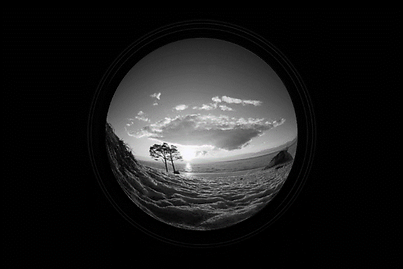Parallax
The Fish-eye lens "fish eye" (or also called parallax) is a photographic lens whose particularity is to have a very short focal length (distance between the optical center of the lens and the image focus, where finds the device's sensor) and therefore a very large field of vision (180° or more). Such a lens produces a rendering similar to what we see when we look through the peephole of our front door.
In a photograph produced with a fish-eye lens, we have the impression that the subject and the environment around this subject are circular. This will make nearby elements appear large. The edges of the image are distorted and the photo is spherical. We will tend to think that these renderings are not usable, but in reality they have multiple interests.
Why choose a Fish-eye lens? What are the different areas of application where this type of lens is used?

The view through a fish-eye lens
A victim of great success among camera users but also on numerous retouching, processing and assisted drawing software, certain applications now offer the Fish-eye effect. This is the case of the Snapchat application which is a free photo and video sharing application from the company. Considering that special lenses can be expensive, this application achieves the same effect using a special filter.
Using fish-eye is a fun and easy way to ensure that every event is captured in its entirety. It was designed for this primary use. It can be used in many disciplines such as astrophotography. In fact, you can equip yourself with a fish-eye lens to take photos of the Milky Way.

Fish-eye photography of the Milky Way
In addition, these lenses can be used to film or photograph extreme athletes, which can bring the viewer into the heart of the photographed action. It is also suitable for large events or for any creative shots.
The main advantage of the Fish-eye lens is first of all its shooting angle compared to slightly more traditional lenses. This asset is effective when it comes to enhancing large spaces because it widens and brings the center of the image closer, giving the impression of zoom.
On the other hand, the abstract and distorted photos produced by the fish-eye can be appreciated by photographers to produce unique and out-of-the-ordinary shots. In addition, the immersion effect it causes offers the impression of experiencing the photographed scene. These factors are of strong artistic interest.
Fish-eye lenses are particularly expensive. You must therefore choose subjects and shooting angles carefully because not everything is suitable for its uses. For example, if we decide to take a photo of a landscape, the photo will unfortunately be unusable because everything will seem too distant. Furthermore, the details and information present on the ends of the image cannot be used as they are to be able to study them. Likewise, distortions in captures can prevent their correct reading and interpretation, particularly in professional and technical uses.
Distortion correction may be necessary depending on intended use. Distortion corresponds to the deformations that will be created by a photographic lens and which modify the magnification depending on the field. In the world of photography, taking perfect shots, that is to say without distortion, is very rare. A more precise technique is possible. This is the case with editing software like Adobe Photoshop which integrates personalized distortion correction tools allowing you to target the distortion of the horizon line without cropping the photo.


Illustration of image distortion correction when capturing a cityscape. We see in particular that the horizon line, curved in the first photo, is straightened in the second after correction.
The effectfish-eye is therefore possible with a lens, lenses that can be attached directly to the phone or using applications to create the effect once the photo is taken. The fact remains that the last option is the least expensive, but will the results using these three solutions be the same?
A fish-eye lens allows you to obtain a very wide angle of view, useful in certain fields of activity, particularly in astrophotography. And this allows you to express your artistic creativity. On the other hand, captures taken with a fish-eye are not always usable and require distortion correction. Cameras can feature wide-angle lenses and correct distortions automatically using digital functions.



